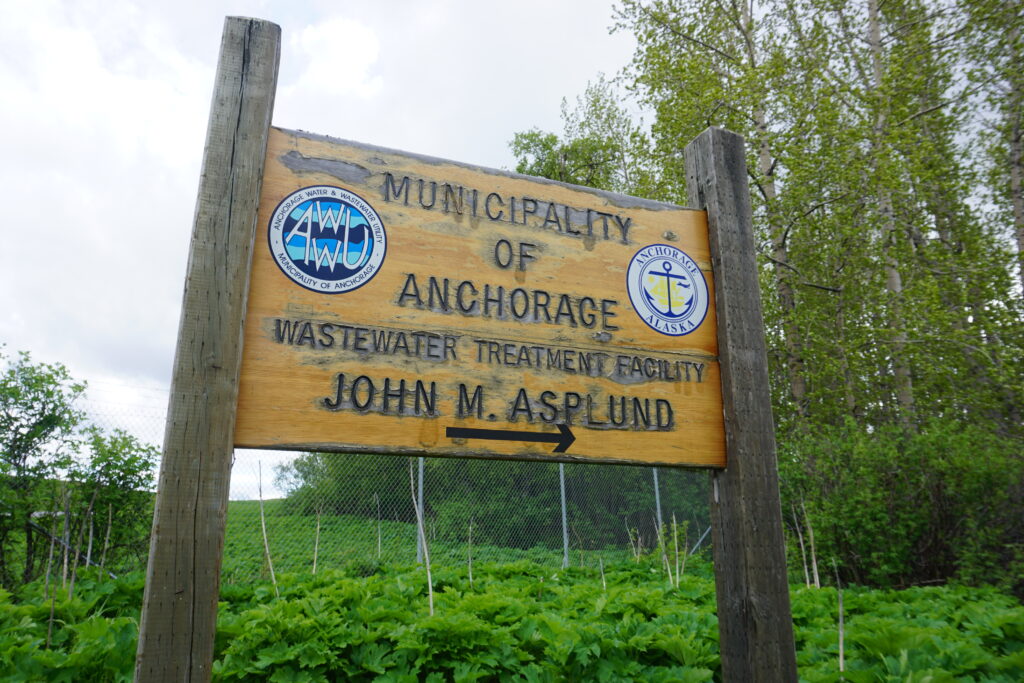A sign, seen on Wednesday, marks the location of the John M. Asplund Wastewater Treatment Facility near Point Woronzof in Anchorage. The plant, the main site for wastewater treatment in the municipality, is part of a national network that tests for disease pathogens. The testing has been helpful, state officials say. (Photo by Yereth Rosen/Alaska Beacon)
The Alaska Division of Public Health is hoping to expand wastewater-monitoring programs that have proved useful in detecting outbreaks of COVID-19 and other respiratory diseases, a report said.
Testing at Anchorage’s John M. Asplund Wastewater Treatment Facility, the municipality’s main wastewater plant, was able to provide notice of a spike in COVID-19 cases in January 2023, several days ahead of patients’ cases that were confirmed by health laboratories, said a bulletin recently issued by the division’s epidemiology section.
The information gleaned from testing at the Anchorage plant is an example of the way wastewater sampling has been used in multiple Alaska communities to monitor community spread of COVID-19 and other contagious diseases like influenza and respiratory syncytial virus, or RSV.
Within Alaska, multiple communities in addition to Anchorage have been using wastewater sampling for that purpose, and for detecting other diseases as well. Sites include Juneau, Fairbanks and Bethel. The testing is funded in part by the U.S. Centers for Disease Control and Prevention.
Anchorage is the only Alaska community that is part of a national WastewaterSCAN network that can detect additional pathogens, such as those causing hepatitis and mpox. The others are part of the CDC’s National Wastewater Surveillance System.
In Bethel, the Yukon-Kuskokwim Health Corp. began testing wastewater samples in October 2022 for viruses that cause COVID-19, influenza and RSV, the epidemiology bulletin said. That monitoring has helped health officials time their influenza vaccinations and distribution of antiviral medications to combat RSV, the bulletin said. In December, the Yukon-Kuskokwim Health Corp., with the help of the CDC, started a project to include tuberculosis and norovirus testing in its wastewater monitoring program, the bulletin said.
The Division of Public Health is working to expand wastewater monitoring throughout the state as part of a strategy “to be better prepared for future pandemics like COVID-19,” the bulletin said. The division plans to launch a workgroup soon with wastewater managers, health officials, laboratories and other parties, the bulletin said.
There are some special Alaska challenges, the bulletin noted. Many communities lack centralized sewer systems, for example. Geographic remoteness also presents difficult logistics and high costs for sampling, transportation to a testing site and actual testing, the bulletin said. Another complication is Alaska’s weather, as snowmelt and rainwater can enter water systems being treated, possibly mixing in pathogens from elsewhere, the bulletin said.
Though it became more heavily used in the COVID-19 pandemic, wastewater testing as a strategy for disease monitoring is not new. In the United States, the practice dates to the 1930s, when scientists began examining wastewater for the presence of poliovirus. The earliest documented use of that type of testing may have been in the mid-1800s, when physician John Snow detected the bacteria that cause cholera in water at a specific water pump in London.
In addition to tracking disease spread, wastewater sampling could also be used to detect community use of opioids.
GET THE MORNING HEADLINES DELIVERED TO YOUR INBOX
The post Alaska health officials point to wastewater sampling as useful disease-tracking tool appeared first on Alaska Beacon.

